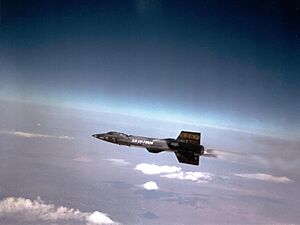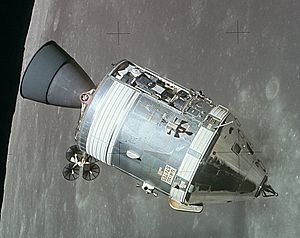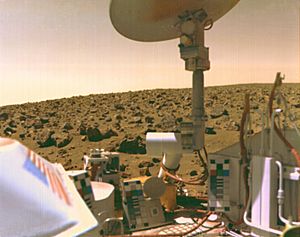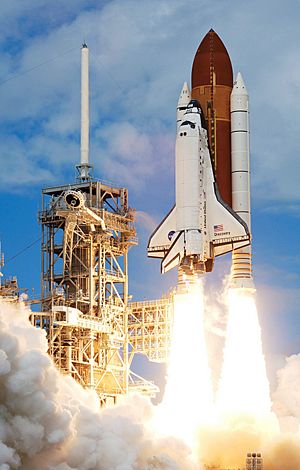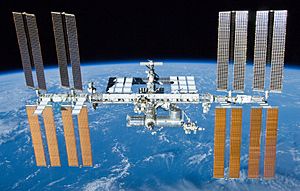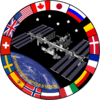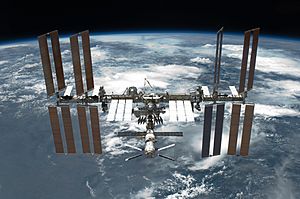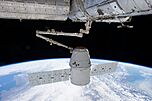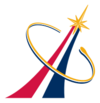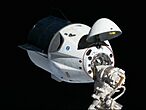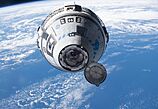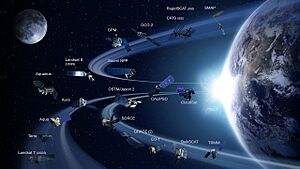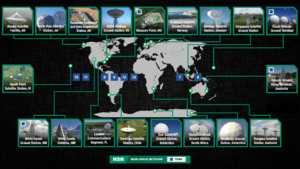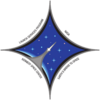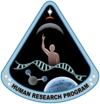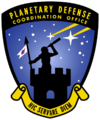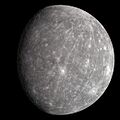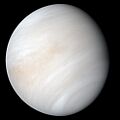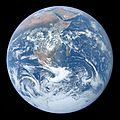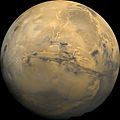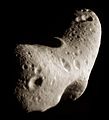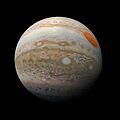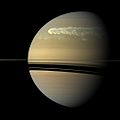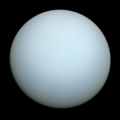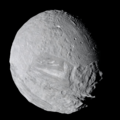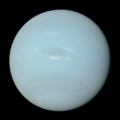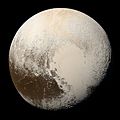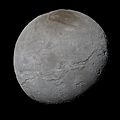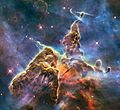NASA facts for kids
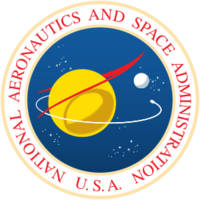
NASA seal
|
|
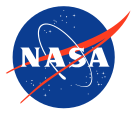 NASA insignia
|
|
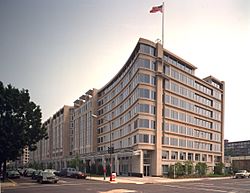
Mary W. Jackson NASA Headquarters building in Washington, D.C.
|
|
| Agency overview | |
|---|---|
| Abbreviation | NASA |
| Formed | July 29, 1958 |
| Preceding agency |
|
| Type | Space agency Aeronautics research agency |
| Jurisdiction | United States Federal Government |
| Headquarters | Mary W. Jackson NASA Headquarters Washington, D.C. 38°52′59″N 77°0′59″W / 38.88306°N 77.01639°W |
|
Administrator
|
Sean Duffy (acting) |
| Deputy Administrator | Vacant |
| Primary spaceports |
|
| Employees | 17,960 (2022) |
| Annual budget | |
The National Aeronautics and Space Administration (NASA) is a special agency of the U.S. government. It is in charge of America's space program, which includes exploring space and researching how things fly. NASA was created in 1958. It took over from an older group called the National Advisory Committee for Aeronautics (NACA). NASA's main goal was to focus on peaceful uses of space science.
Since then, NASA has led many important space missions. These include Project Mercury, Project Gemini, the Apollo program that landed humans on the Moon, the Skylab space station, and the Space Shuttle. Today, NASA helps run the International Space Station (ISS). It also works on new spacecraft like Orion and the Space Launch System for the Artemis program to return to the Moon.
NASA's science teams study Earth using satellites like the Earth Observing System. They also explore the Solar System with robotic spacecraft such as New Horizons and rovers like Perseverance. NASA also studies faraway things in space, like the Big Bang, using powerful telescopes such as the James Webb Space Telescope.
Contents
- How NASA Began
- What NASA is Doing Now
- Working with Others
- How NASA is Managed
- Sustainability and Environment
- NASA in Media
- Images for kids
- See also
How NASA Began
From Airplanes to Space
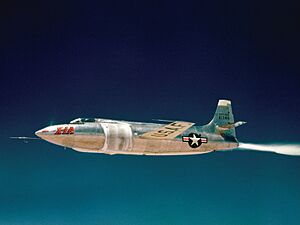
NASA's story starts with the National Advisory Committee for Aeronautics (NACA). In 1914, the United States realized it was behind Europe in aviation. To catch up, the U.S. Congress created NACA in 1915. NACA's job was to research and develop new flying technologies. For 40 years, NACA helped the U.S. Air Force, Army, Navy, and civilian planes. After World War II, NACA became interested in guided missiles and super-fast aircraft. They helped create and test the Bell X-1, which could fly faster than sound. NACA's interest in space grew from its rocket research.
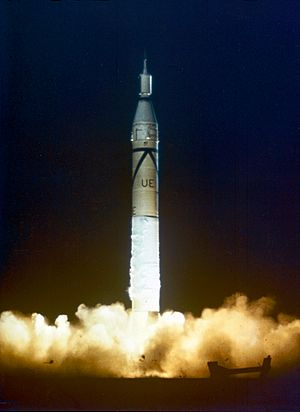
Then, in 1957, the Soviet Union launched Sputnik 1, the first satellite in space. This started the "Space Race." Even though NACA had rocket programs, the U.S. Navy was supposed to launch America's first satellite. But they had problems. So, the Army's Ballistic Missile Agency launched Explorer 1, America's first satellite, on February 1, 1958.
The U.S. government decided to separate military and civilian space programs. So, NASA was created on July 29, 1958. It officially started on October 1, 1958. NACA's 8,000 employees and three main research labs became the core of NASA. NASA also took over the Navy's Project Vanguard, the Army's Jet Propulsion Laboratory (JPL), and the Army Ballistic Missile Agency, which included rocket expert Wernher von Braun. This made NASA the main U.S. agency for civilian space exploration.
First Flights into Space
Before NASA was formed, the U.S. military had plans for human spaceflight. These plans became the basis for Project Mercury. NASA created the Space Task Group to manage this program. It would send astronauts on short sub-orbital flights and longer orbital flights. Even though NASA wanted civilian astronauts, President Eisenhower decided they should be chosen from the military. The first seven astronauts, known as the Mercury 7, included pilots from the Air Force, Navy, and Marine Corps.
On May 5, 1961, Alan Shepard became the first American in space. He flew a suborbital flight in Freedom 7. This happened less than a month after the Soviet Yuri Gagarin became the first human to orbit Earth. NASA's first orbital flight was on February 20, 1962, with John Glenn in Friendship 7. He orbited Earth three times. The last Mercury mission was in May 1963, with Gordon Cooper flying 22 orbits over 34 hours. The Mercury Program was a big success. It showed that humans could orbit in space and that NASA could track and control spacecraft.
While focusing on space, NASA also continued its airplane research. They worked on planes that could fly extremely fast, beyond supersonic speeds. The North American X-15 was a joint NASA-Air Force project. This hypersonic test aircraft was the first non-spacecraft to fly into outer space. The X-15 also helped test technologies for the Apollo program.
Landing on the Moon
The "Cold War" between the U.S. and the Soviet Union heated up. This led President John F. Kennedy to challenge NASA to land an American on the Moon and bring them back safely by the end of the 1960s. He appointed James E. Webb to lead NASA in this huge goal. On May 25, 1961, President Kennedy announced this goal to Congress. He said it would be the most impressive and important space project, even though it would be very difficult and expensive.
President Kennedy gave his famous "We choose to go to the Moon" speech on September 12, 1962, at Rice University. He hoped to get public support for the Apollo program. Even with some people against the idea, President Kennedy protected NASA's growing budget. At its peak, about 5% of Americans worked on some part of the Apollo program.
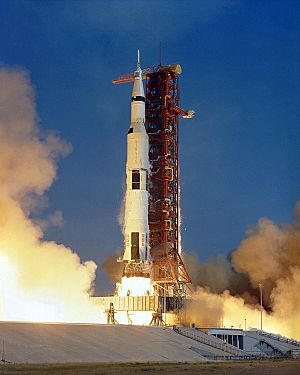
NASA asked the Air Force to assign Major General Samuel C. Phillips to lead the Apollo program. The powerful Saturn V rocket was developed by Wernher von Braun's team. The Apollo spacecraft was built by North American Aviation, and the Apollo Lunar Module was built by Grumman.
To prepare for the Moon mission, NASA started Project Gemini. Using a modified Air Force rocket, the Gemini capsule could hold two astronauts for flights lasting over two weeks. Gemini missions were important because they used fuel cells instead of batteries. They also had the first American spacewalks and practiced meeting up with other spacecraft in orbit.
Earlier missions, like the Ranger Program, tried to explore the Moon but often failed. The Lunar Orbiter program was more successful. It mapped the Moon's surface to find good landing spots for Apollo. The Surveyor program sent uncrewed landers to the Moon. They practiced landing and taking pictures of the surface. Even after the tragic Apollo 1 fire, which killed three astronauts, the program continued.
Apollo 8 was the first crewed spacecraft to leave Earth's orbit and reach the Moon. The crew orbited the Moon ten times on December 24 and 25, 1968. They then returned safely to Earth. The three Apollo 8 astronauts were the first humans to see Earth as a whole globe in space. They were also the first to see an "Earthrise" and photograph the far side of the Moon.
The first Moon landing was by Apollo 11. Commanded by Neil Armstrong with astronauts Buzz Aldrin and Michael Collins, Apollo 11 was a huge moment for NASA. It marked the end of the Space Race, as the Soviet Union stopped its Moon landing efforts. When Neil Armstrong stepped onto the Moon, he said the famous words:
That's one small step for man, one giant leap for mankind.
NASA completed six Moon landings as part of the Apollo program. Apollo 17 was the last mission in 1972.
After Apollo: Space Stations and International Cooperation
After the Apollo missions, NASA launched its first space station, Skylab, in 1973. Skylab used parts from the Apollo and Saturn rockets. It was damaged during launch, and astronauts had to do spacewalks to fix it. Skylab hosted nine missions and was used until 1974. It fell back to Earth in 1979.
In 1975, the Apollo–Soyuz mission was a big step for international cooperation. It was the first time a U.S. spacecraft docked with a Soviet Soyuz capsule. This was a major diplomatic success during the Cold War. It was also the last flight of the Apollo capsule.
Exploring Other Planets
In the 1960s, NASA began sending robotic probes to other planets. The Mariner program sent probes to Venus, Mars, and Mercury. The Jet Propulsion Laboratory (JPL) led these missions. They made important discoveries about the inner planets. However, Congress stopped funding new interplanetary missions for a while so NASA could focus on Apollo.
After Apollo, NASA started launching probes to other planets again. They explored Venus, which is hot and harsh. Missions like Pioneer Venus project and Magellan mapped Venus's surface.
Mars has always fascinated NASA, as scientists wondered if it could have life. Early missions like Mariner 5, Mariner 6, and Mariner 7 flew by Mars. Mariner 9 was the first to orbit Mars. In 1975, the Viking program sent two landers to Mars in 1976. Later, in 1996, the Mars Global Surveyor orbiter and Mars Pathfinder landed. Mars Pathfinder deployed the first Mars rover, Sojourner.
In the early 2000s, the 2001 Mars Odyssey orbiter reached Mars. In 2004, the Spirit and Opportunity rovers landed. These were followed by the Mars Reconnaissance Orbiter in 2005 and the Phoenix lander in 2007. The Curiosity rover landed in 2012. It found that radiation levels on Mars were similar to the International Space Station. This increased the chance of human exploration. Curiosity also found key chemical ingredients for life. In 2013, the Mars Atmosphere and Volatile Evolution (MAVEN) mission studied Mars's upper atmosphere. In 2018, InSight studied Mars's inside. The Perseverance rover, which landed in 2021, carried the first helicopter on another planet, named Ingenuity.
NASA also sent the MESSENGER probe to Mercury in 2004. It was the first time a solar sail was used. Probes also went to the outer Solar System. Pioneer 10 was the first to fly by Jupiter, and Pioneer 11 gave the first close-up view. Both probes eventually left our Solar System. The Voyager program, launched in 1977, flew by Jupiter, Saturn, Neptune, and Uranus before heading out of the Solar System.
The Galileo spacecraft was the first to orbit Jupiter. It found signs of oceans under the surface of Europa. The Cassini–Huygens mission, a joint effort with European and Italian space agencies, went to Saturn's moon Titan. It found liquid hydrocarbon lakes on Titan and water oceans on Enceladus. These moons, along with Mars and Europa, are thought to be places where life could exist. Finally, the New Horizons mission, launched in 2006, was the first spacecraft to visit Pluto and the Kuiper belt.
Beyond probes, NASA has launched many space telescopes. The Orbiting Astronomical Observatory in the 1960s were NASA's first orbital telescopes. They observed ultraviolet, gamma-ray, x-ray, and infrared light. The Uhuru satellite was the first X-ray telescope. It mapped 85% of the sky and found many black holes.
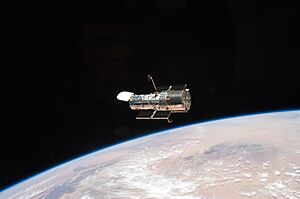
The Great Observatories program, launched in the 1990s and early 2000s, includes some of NASA's most powerful telescopes. The Hubble Space Telescope, launched in 1990, can see galaxies 15 billion light-years away. It had a mirror problem, but NASA fixed it using computer help and Space Shuttle repair missions. The Compton Gamma Ray Observatory, launched in 1991, found a possible source of antimatter in the Milky Way. The Chandra X-ray Observatory, launched in 1999, studies black holes, quasars, and dark matter. It helped observe the Sagittarius A* black hole at the center of our galaxy. The Spitzer Space Telescope, an infrared telescope launched in 2003, discovered brown dwarf stars.
Other telescopes, like the Cosmic Background Explorer and the Wilkinson Microwave Anisotropy Probe, helped prove the Big Bang theory. The James Webb Space Telescope, launched in 2021, is a successor to Hubble. It observes infrared light to study the formation of the first galaxies. The Kepler space telescope, launched in 2009, found planets orbiting other stars that might be like Earth and could have life.
NASA also launched satellites to study Earth. The Television Infrared Observation Satellite (TIROS) in 1960 was the first weather satellite. NASA also launched its first Earth observation satellite, Landsat, in 1972. This led to the development of GOES satellites and the discovery of Ozone depletion.
The Space Shuttle Era
NASA had been working on spaceplanes since the 1960s. They saw a spaceplane as a way to provide regular and cheaper support to a space station. This station would then be a base for missions to the Moon and Mars. A reusable launch vehicle would also mean no more expensive, one-time-use rockets like the Saturn V.
In 1972, official development of the Space Shuttle began. NASA acquired six orbiters: Enterprise, Columbia, Challenger, Discovery, Atlantis, and Endeavour.
The Space Shuttle program also changed how NASA chose astronauts. Before, most astronauts were military test pilots. With the Shuttle, NASA started recruiting more scientists and technical experts who were not in the military. Sally Ride became the first American woman in space on STS-7. This new process also allowed astronauts from other countries to fly with NASA.
The first Space Shuttle flight was in 1981 with Columbia on the STS-1 mission. NASA wanted the Space Shuttle to replace other rockets. The Shuttle's Spacelab payload, developed by the European Space Agency, greatly increased the scientific work that could be done on missions.
NASA launched its first commercial satellites on the STS-5 mission. In 1984, the STS-41-C mission performed the world's first satellite repair in space. The Challenger captured and fixed the Solar Maximum Mission satellite. The Shuttle could also bring broken satellites back to Earth for repair and relaunch.
Even though the Space Shuttle brought a new era of spaceflight, it was criticized for not being as reusable or cheap as promised. In 1986, the Challenger disaster on the STS-51L mission killed all seven astronauts during launch. This grounded the entire fleet for 36 months. When the Space Shuttle returned to flight with the STS-26 mission, it had been greatly improved for safety.

After the Soviet Union broke up, Russia and the U.S. started the Shuttle-Mir program. The first Russian cosmonaut flew on the STS-60 mission in 1994. The Discovery met up with the Russian Mir space station on the STS-63 mission. Then, Atlantis' STS-71 mission docked with Mir and transferred supplies and people. The Shuttle-Mir program continued until 1998.
In 2003, a second Space Shuttle, Columbia, was destroyed upon reentry during the STS-107 mission. All seven astronauts died. This accident led to the Space Shuttle program being retired. President George W. Bush directed that the Space Shuttle be retired after the International Space Station was completed. The Space Shuttle returned to flight in 2006. It performed missions to service the Hubble Space Telescope. The program was retired after the STS-135 mission to the International Space Station in 2011.
Space Stations: Working Together in Orbit
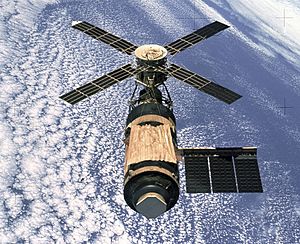
NASA never gave up on the idea of a space station after Skylab. The agency pushed for a larger space station as soon as the Space Shuttle started flying. They presented it as a lab, a repair station, and a starting point for Moon and Mars missions. President Ronald Reagan strongly supported this idea. In 1984, he directed NASA to develop a permanently crewed space station within a decade.
In 1985, NASA proposed Space Station Freedom. Both NASA and President Reagan wanted it to be an international project. This would make the program more legitimate. However, some at NASA worried that international partners would reduce NASA's control. There were also concerns about sharing sensitive space technologies. But in 1985, an international agreement was signed with 13 countries, including European Space Agency members, Canada, and Japan.
Despite being the first international space program, Space Station Freedom was controversial because of its cost. Several redesigns in the early 1990s cut many of its features. Even with calls to stop the program, it continued. By 1992, it had created 75,000 jobs across 39 states. In 1993, President Bill Clinton tried to cut NASA's budget. He directed that costs be greatly reduced, jobs not be lost, and the Russians be included.
In 1993, the Clinton Administration announced that Space Station Freedom would become the International Space Station. This was part of an agreement with Russia. This helped Russia keep its space program going with U.S. money. While the U.S. built and launched most of the ISS, Russia, Canada, Japan, and the European Space Agency also contributed parts. NASA said costs would be $17.4 billion, but they kept rising. NASA had to move money from other programs to keep the ISS going. The total cost of the station was $150 billion, with the U.S. paying two-thirds. After the Space Shuttle Columbia disaster in 2003, NASA had to rely on Russian Soyuz launches for its astronauts. The Space Shuttle's retirement in 2011 sped up the station's completion.
The ISS program is expected to continue until 2030. After that, the space station will be retired and safely brought down to Earth.
Commercial Space and Returning to the Moon
After the Space Shuttle Columbia disaster in 2003, President Bush started the Constellation program. This program was meant to replace the Space Shuttle and send astronauts beyond Earth's orbit, back to the Moon. This program was later canceled by the Obama Administration. Former astronauts like Neil Armstrong warned that if the U.S. didn't get new ways to send humans to space, it might fall behind other space powers.
For a long time, some people wanted NASA to involve private companies more in space exploration. In the 1990s, NASA and Lockheed Martin worked together on the Lockheed Martin X-33 demonstrator. This was meant to replace the Space Shuttle, but it was canceled in 2001 due to technical problems. Still, it was the first time a commercial space company put a lot of its own money into developing a spacecraft. The rise of space tourism also showed NASA that not only governments would send people to space. Dennis Tito, an American investment manager, was the first space tourist. He paid Russia to fly to the International Space Station for four days, even though NASA was against it.
People like former astronaut Buzz Aldrin supported this new commercial approach. They said it would let NASA go back to its main job of research and development. Commercial companies would handle orbital operations. This would allow NASA to focus on deep space exploration and returning humans to the Moon and Mars. NASA embraced this idea with its Commercial Crew Program. It started by hiring companies to deliver cargo to the International Space Station. The first crewed mission under this program was SpaceX Crew-1. This meant that for the first time since the Space Shuttle retired, NASA could launch its own astronauts from the U.S. on an American spacecraft. This ended a decade of relying on Russia.
In 2019, NASA announced the Artemis program. Its goal is to return humans to the Moon and set up a permanent presence there. This program also includes the Artemis Accords with partner nations. These accords set rules for how countries will behave and work together in space, especially on the Moon.
In 2023, NASA created the Moon to Mars Program office. This office oversees all the projects and plans for exploring the Moon and Mars.
What NASA is Doing Now
Human Spaceflight Missions
International Space Station (1993–present)
The International Space Station (ISS) combines projects from NASA, Russia, Europe, and Japan. NASA first planned to build its own station, but budget limits led to these projects joining together in 1993. NASA, the Russian Federal Space Agency (RKA), the Japan Aerospace Exploration Agency (JAXA), the European Space Agency (ESA), and the Canadian Space Agency (CSA) all manage the ISS. The station is made of many parts built around the world. These parts were launched by Russian and American rockets. Building the station in space began in 1998.
Long missions to the ISS are called ISS Expeditions. Astronauts usually stay for about six months. The ISS has been continuously occupied since November 2, 2000. It has been visited by astronauts from 15 different countries.
You can see the station from Earth without a telescope. It is the largest artificial satellite orbiting Earth. Russian Soyuz and American Dragon and Starliner spacecraft carry astronauts to and from the ISS. Uncrewed cargo spacecraft also deliver supplies. Before the Space Shuttle retired in 2011, it also carried cargo and crew. Between 2011 and 2020, American astronauts relied only on the Soyuz for transport. The most people on the ISS at one time has been thirteen.
The ISS program is expected to continue until 2030. After that, the station will be safely deorbited and destroyed.
Commercial Resupply Services (2008–present)
Commercial Resupply Services (CRS) are contracts for private companies to deliver cargo to the International Space Station. NASA signed its first CRS contracts in 2008. They awarded $1.6 billion to SpaceX for 12 cargo Dragon flights and $1.9 billion to Orbital Sciences for eight Cygnus flights. These contracts covered deliveries until 2016. Both companies developed their own rockets to launch these spacecraft.
SpaceX flew its first resupply mission in 2012. Orbital Sciences followed in 2014. In 2015, NASA extended these contracts. A second phase of contracts (CRS-2) was awarded in January 2016 to Orbital ATK, Sierra Nevada Corporation (for their Dream Chaser), and SpaceX (for Dragon 2). These flights began in 2019 and are expected to last through 2024. In March 2022, NASA added six more CRS-2 missions for both SpaceX and Northrop Grumman (formerly Orbital).
Northrop Grumman successfully delivered Cygnus NG-17 to the ISS in February 2022. In July 2022, SpaceX launched its 25th CRS flight. The Dream Chaser spacecraft is scheduled for its first test launch in the first half of 2024.
Commercial Crew Program (2011–present)
The Commercial Crew Program (CCP) provides crew transportation to and from the International Space Station. Private companies operate these services under contract to NASA. SpaceX began providing service in 2020 using the Crew Dragon spacecraft. Boeing's Starliner spacecraft began service in 2024. NASA has contracted for six missions from Boeing and fourteen from SpaceX. This ensures enough support for the ISS through 2030.
The spacecraft are owned and operated by the companies. Each mission sends up to four astronauts to the ISS. Flights happen about every six months and last for about six months. A spacecraft stays docked to the ISS during its mission. Between the retirement of the Space Shuttle in 2011 and the first CCP mission in 2020, NASA relied on the Soyuz program to transport its astronauts.
A Crew Dragon spacecraft launches on a Falcon 9 Block 5 rocket. The capsule returns to Earth by splashing down in the ocean near Florida. The program's first mission launched on November 16, 2020. Boeing Starliner flights launch on an Atlas V rocket. Instead of splashing down, Starliner capsules land on land with airbags in the western United States.
Artemis Program: Back to the Moon and Beyond (2017–present)
Since 2017, NASA's human spaceflight program has been the Artemis program. It involves U.S. private space companies and international partners like ESA, JAXA, and CSA. The goal is to land "the first woman and the next man" near the Moon's south pole by 2025. Artemis is the first step toward having a lasting human presence on the Moon. This will help companies build a lunar economy and eventually send humans to Mars.
The Orion Crew Exploration Vehicle was kept from the canceled Constellation program for Artemis. Artemis I was the first uncrewed launch of the Space Launch System (SLS). It sent an Orion spacecraft on a long orbit around the Moon.
The first steps back to crewed lunar missions will be Artemis II. This mission will include the Orion crew module, powered by the SLS. It is expected to launch no later than April 2026. This 10-day mission will briefly send a crew of four around the Moon. Artemis III aims to be the first crewed lunar landing since Apollo 17. It is scheduled for no earlier than mid-2027.
To support Artemis, NASA funds private companies to land robotic probes on the Moon. This is part of the Commercial Lunar Payload Services program. NASA has awarded contracts to companies like Intuitive Machines, Firefly Space Systems, and Astrobotic.
On April 16, 2021, NASA chose the SpaceX Lunar Starship as its Human Landing System. The SLS rocket will launch four astronauts in the Orion spacecraft to lunar orbit. There, they will transfer to SpaceX's Starship for the final trip to the Moon's surface.
In November 2021, it was announced that the goal of landing astronauts on the Moon by 2024 had moved to no earlier than 2027. Artemis I launched on November 16, 2022, and returned safely on December 11, 2022. As of April 2025, NASA plans to launch Artemis II in April 2026 and Artemis III in 2027. More Artemis missions, Artemis IV, Artemis V, and Artemis VI, are planned between 2028 and 2031.
NASA's next big space project is building the Lunar Gateway. This is a small space station that will orbit the Moon. It will be designed mainly for humans to visit, not live on continuously. Building the Gateway is expected to start in 2027. The first two parts, the Power and Propulsion Element (PPE) and the Habitation and Logistics Outpost (HALO), will launch then. Operations on the Gateway will begin with the Artemis IV mission in 2028.
In 2017, Congress told NASA to get humans to Mars orbit (or the surface) by the 2030s.
Commercial Low Earth Orbit Development (2021–present)
The Commercial Low Earth Orbit Destinations program is a NASA project to support commercial space stations. NASA hopes these stations will replace the International Space Station by the end of this decade. Three companies have been chosen: Blue Origin (and partners) with their Orbital Reef station, Nanoracks (and partners) with their Starlab Space Station, and Northrop Grumman with a station based on the HALO-module for the Gateway station.
Robotic Exploration Missions
NASA has sent many uncrewed and robotic missions into space. More than 1,000 uncrewed missions have explored Earth and the Solar System.
How Missions Are Chosen
NASA has a system for planning, choosing, developing, and operating robotic missions. This system sets limits on cost, time, and technical risk. It allows different teams from NASA, other U.S. government groups, and companies to propose their mission ideas. There are four main programs for developing missions:
Explorer Program
The Explorer program has been around since the early days of the U.S. Space program. Today, it has three types of missions: Small Explorers (SMEX), Medium Explorers (MIDEX), and University-Class Explorers (UNEX). This program offers frequent chances for innovative, lower-cost missions in heliophysics (Sun studies) and astrophysics (space studies). Small Explorer missions must cost NASA less than $150 million (in 2022 dollars). Medium Explorer missions typically have a cost limit of $350 million. The Explorer program office is at NASA Goddard Space Flight Center.
Discovery Program
The NASA Discovery program develops robotic spacecraft for planetary science. It allows scientists and engineers to form a team and propose a solution for specific goals. Their ideas compete against other proposals. Cost limits vary, but recent missions had a $500 million cap for NASA. The Planetary Mission Program Office, located at NASA Marshall Space Flight Center, manages both Discovery and New Frontiers missions.
On June 2, 2021, NASA Administrator Bill Nelson announced that the DAVINCI+ and VERITAS missions were chosen to launch to Venus in the late 2020s. They beat out proposals for missions to Jupiter's moon Io and Neptune's moon Triton. Each mission is estimated to cost $500 million, with launches expected between 2028 and 2030.
New Frontiers Program
The New Frontiers program focuses on specific Solar System exploration goals that planetary scientists say are top priorities. These are medium-sized spacecraft missions that aim for high-science returns. New Frontiers builds on the Discovery program's approach but allows for higher costs and longer schedules. Cost limits vary, but recent missions have had a $1 billion cap. Because of the higher cost and longer missions, new opportunities for this program happen less often, usually every few years. OSIRIS-REx and New Horizons are examples of New Frontiers missions.
NASA has said that the next chance to propose for the fifth round of New Frontiers missions will be no later than fall 2024.
Large Strategic Missions
Large strategic missions (also called Flagship missions) are big, important missions. They are usually developed and managed by large teams across several NASA centers. The mission itself is the main program. The James Webb Space Telescope is an example of a strategic mission that took over 20 years to develop. Strategic missions are planned as needed, based on program goals and priorities. Missions like Voyager, if developed today, would be strategic missions. Three of the Great Observatories were strategic missions: the Chandra X-ray Observatory, the Compton Gamma Ray Observatory, and the Hubble Space Telescope. Europa Clipper is the next large strategic mission NASA is developing.
Planetary Science Missions
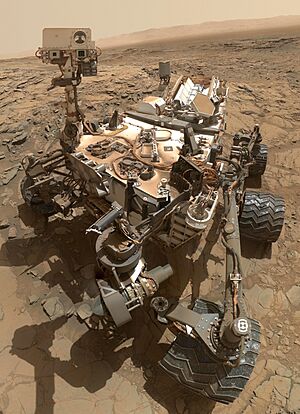
NASA continues to play a big role in exploring the Solar System. Current missions are studying more than five places in our Solar System. These include the Moon (Lunar Reconnaissance Orbiter), Mars (Perseverance rover), Jupiter (Juno), asteroid Bennu (OSIRIS-REx), and Kuiper Belt Objects (New Horizons). The Juno mission will make more flybys of Jupiter's moon Io in 2023 and 2024. Voyager 1 and Voyager 2 continue to send data back to Earth as they travel into interstellar space.
On November 26, 2011, NASA's Mars Science Laboratory mission launched successfully for Mars. The Curiosity rover landed on Mars on August 6, 2012. It then began searching for signs of past or present life on Mars.
In September 2014, NASA's MAVEN spacecraft entered Mars orbit. As of October 2022, it continues to study the atmosphere of Mars. NASA's ongoing Mars studies include detailed surveys by the Perseverance rover.
NASA's Europa Clipper, launched in October 2024, will study Jupiter's moon Europa. It will do this through a series of flybys while orbiting Jupiter. Dragonfly will send a robotic helicopter to Saturn's largest moon, Titan. As of May 2021, Dragonfly is scheduled to launch in June 2027.
Astrophysics Missions

NASA's Science Mission Directorate Astrophysics division manages the agency's astrophysics science. NASA has invested a lot in developing and operating various space telescopes. These telescopes help us study the cosmos across different types of light.
The Great Observatories, launched in the 1980s and 1990s, have provided a lot of information for scientists. The first, the Hubble Space Telescope, launched in 1990 and still works today. This is partly thanks to past servicing missions by the Space Shuttle. The other active great observatory is the Chandra X-ray Observatory (CXO). It launched in July 1999 and studies X-ray sources that are hard to see from Earth.
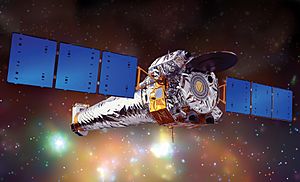
The Imaging X-ray Polarimetry Explorer (IXPE) is a space observatory launched in December 2021. It helps us understand how X-rays are made in objects like neutron stars and black holes. IXPE is a team effort between NASA and the Italian Space Agency (ASI). It is part of NASA's Small Explorers program (SMEX).
The Neil Gehrels Swift Observatory launched in November 2004. It observes gamma-ray bursts and their afterglows. This mission was developed with Goddard Space Flight Center (GSFC) and international partners. The Fermi Gamma-ray Space Telescope (FGST) is another gamma-ray observatory. It launched in June 2008 and is used for gamma-ray astronomy.
The James Webb Space Telescope (JWST), launched in December 2021, operates far from Earth. JWST is very sensitive to infrared light. Its clear images allow it to see more distant, faint, or older objects than telescopes like Hubble.
Earth Sciences Program Missions (1965–present)
NASA Earth Science is a big program that uses many systems on Earth and in space. Its goal is to better understand our planet and how it changes due to nature and humans. Many systems have been developed over decades to improve predictions for weather, climate, and other environmental changes. Some current operating spacecraft include: Aqua, Aura, Orbiting Carbon Observatory 2 (OCO-2), Gravity Recovery and Climate Experiment Follow-on (GRACE FO), and Ice, Cloud, and land Elevation Satellite 2 (ICESat-2).
NASA is also designing new Earth Observing Systems. These will study and respond to climate change, natural hazards, forest fires, and farming processes in real-time. The GOES-T satellite (called GOES-18 after launch) joined the U.S. weather monitoring satellites in March 2022.
NASA also runs the Earth Science Data Systems (ESDS) program. This program manages NASA's Earth science data from when it's collected to when it's shared. The main goal of ESDS is to get the most scientific value from NASA's missions for scientists and society.
Space Operations
NASA invests in ground and space systems to support its science and exploration. The agency has access to rocket launch capabilities and ground stations to support its spacecraft.
Deep Space Network (1963–present)
The NASA Deep Space Network (DSN) is the main ground station system for NASA's interplanetary spacecraft and some Earth-orbiting missions. It has ground stations in California, Spain, and Australia. These stations are placed about 120 degrees apart around the Earth. This allows them to communicate with spacecraft throughout the Solar System as Earth rotates. The system is controlled 24/7 at JPL in California. It manages communications with up to 40 spacecraft.
Near Space Network (1983–present)
The Near Space Network (NSN) provides services like sending data, commands, and tracking for satellites in various orbits around Earth and the Moon. The NSN combines ground stations from the Near-Earth Network and the Tracking and Data Relay Satellite System (TDRS). TDRS satellites orbit Earth and provide continuous real-time coverage for rockets and low Earth orbit NASA missions.
The NSN has 19 ground stations worldwide. It averages between 120 and 150 spacecraft contacts a day. The system is managed by the Goddard Space Flight Center.
Sounding Rocket Program (1959–present)
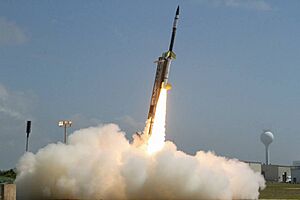
The NASA Sounding Rocket Program (NSRP) is at the Wallops Flight Facility. It provides launch capabilities and support for suborbital missions. The program has been running since 1959. The NSRP team conducts about 20 missions per year from Wallops and other locations worldwide. This allows scientists to collect data "where it occurs." The program supports science in Earth studies, heliophysics, and astrophysics.
In June 2022, NASA launched its first rocket from a commercial spaceport outside the U.S. It launched a Black Brant IX from Australia.
Launch Services Program (1990–present)
The NASA Launch Services Program (LSP) buys launch services for NASA's uncrewed missions. It also oversees launch preparation. Since 1990, NASA has bought expendable launch vehicle services directly from commercial companies when possible. These rockets can reach all types of orbits and are good for launching Earth-orbit and interplanetary missions. LSP operates from Kennedy Space Center.
Aeronautics Research
The Aeronautics Research Mission Directorate (ARMD) is one of NASA's five main divisions. It is responsible for NASA's aeronautical research. This research helps commercial, military, and general aviation. ARMD does its research at four NASA facilities: Ames Research Center and Armstrong Flight Research Center in California, Glenn Research Center in Ohio, and Langley Research Center in Virginia.
NASA X-57 Maxwell Aircraft (2016–present)
The NASA X-57 Maxwell is an experimental aircraft. NASA is developing it to show how an all-electric aircraft can be very efficient. The main goal is to create electric flight technology that can also be certified as safe to fly. The program has several phases to gradually improve the aircraft. The first version of the aircraft has completed ground testing and is approaching its first flights. In mid-2022, the X-57 was scheduled to fly before the end of the year.
Next Generation Air Transportation System (2007–present)
NASA works with the Federal Aviation Administration (FAA) and industry to modernize the U.S. National Airspace System (NAS). This effort began in 2007, aiming for major updates by 2025. The modernization wants to make air travel safer, more efficient, and reduce its environmental impact of aviation. NASA's contributions include developing advanced tools that give air traffic controllers and pilots more accurate real-time information about traffic, weather, and routes.
Technology Research
Nuclear Power and Propulsion in Space (Ongoing)
NASA uses technologies like the multi-mission radioisotope thermoelectric generator (MMRTG). This is a type of generator that uses heat from radioactive materials to power spacecraft. Shortages of the needed plutonium-238 have limited deep space missions since 2000. For example, New Horizons 2 was not developed because of this shortage.
In July 2021, NASA announced contracts to develop nuclear thermal propulsion reactors. Three companies will design different reactors over 12 months for NASA and the U.S. Department of Energy to evaluate. NASA's space nuclear technologies are led by its Space Technology Mission Directorate.
In January 2023, NASA announced a partnership with DARPA on the Demonstration Rocket for Agile Cislunar Operations (DRACO) program. This program aims to test a nuclear thermal rocket engine in space. This technology would help NASA missions to Mars. In July 2023, NASA and DARPA announced a $499 million award to Lockheed Martin to design and build an experimental nuclear thermal rocket to launch in 2027.
Other Initiatives
The Socioeconomic Data and Applications Center (SEDAC), founded in 1994, focuses on collecting and sharing data about how humans interact with the environment. SEDAC combines Earth science and social data.
Free Space Optics. NASA hired a company to study using Free Space Optics (FSO) to communicate with ground stations using lasers.
Water Extraction from Lunar Soil. On July 29, 2020, NASA asked American universities to propose new ways to get water from the lunar soil and develop power systems. This idea will help NASA explore the Moon in a sustainable way.
In 2024, the U.S. Government asked NASA to create a Time standard for the Moon. This standard will be called Coordinated Lunar Time and is expected to be ready in 2026.
Human Spaceflight Research (2005–present)

NASA's Human Research Program (HRP) studies how space affects human health. It also develops ways to counter these effects and technologies for human space exploration. The medical effects of space travel are limited in low Earth orbit or on trips to the Moon. But travel to Mars is much longer and deeper into space. This can cause serious medical issues. These include bone loss, radiation exposure, vision changes, and heart problems. To study and diagnose these issues, HRP identifies or develops small, portable instruments to monitor astronauts' health. For example, on May 13, 2022, NASA and SpaceX Crew-4 astronauts successfully tested a biomedical analyzer on the ISS.
Planetary Defense (2016–present)
NASA created the Planetary Defense Coordination Office (PDCO) in 2016. Its job is to find and track dangerous near-Earth objects (NEO), like asteroids and comets. It also develops ways to protect Earth from these threats. The PDCO provides quick and accurate information to the government and public about close approaches by potentially hazardous objects. This office is part of the Science Mission Directorate's Planetary Science Division.
The PDCO built on earlier efforts by the U.S., Europe, and other nations. Since 1998, they had been scanning the sky for NEOs in a project called Spaceguard.
Finding Near Earth Objects (1998–present)
Since the 1990s, NASA has run many NEO detection programs from Earth-based observatories. This has greatly increased the number of objects found. Many asteroids are very dark. Those near the Sun are harder to spot from Earth-based telescopes, which observe at night. NEOs inside Earth's orbit only reflect some light.
In 1998, the United States Congress told NASA to find 90% of near-Earth asteroids larger than 1 kilometer (0.6 miles) in diameter by 2008. These asteroids could cause global damage. This goal was met by 2011. In 2005, the goal was expanded to find 90% of NEOs 140 meters (460 feet) or larger by 2020. As of January 2020, less than half of these had been found. Objects of this size hit Earth only about once every 2,000 years.
In January 2020, NASA officials estimated it would take 30 years to find all objects meeting the 140-meter size criteria. This was more than twice the time set in the 2005 goal. In June 2021, NASA approved the development of the NEO Surveyor spacecraft. This will reduce the time to achieve the goal to 10 years.
Robotic Missions for Planetary Defense
NASA has included planetary defense goals in several ongoing missions.
In 1999, NASA visited 433 Eros with the NEAR Shoemaker spacecraft. It orbited the asteroid in 2000, taking close-up images. NEAR Shoemaker was the first spacecraft to orbit and land on an asteroid. This helped us understand these objects better.
OSIRIS-REx used its instruments to track and image Bennu. This helps NASA scientists figure out its exact position and orbit. Bennu could come close to Earth in the next 100–200 years. The precision from OSIRIS-REx will help scientists better predict how Bennu's path might change.
The WISE/NEOWISE mission launched in 2009 as an infrared space telescope. In 2013, NASA repurposed it as the NEOWISE mission to find potentially dangerous near-Earth asteroids and comets. Its mission has been extended into 2023.
NASA and Johns Hopkins Applied Physics Laboratory (JHAPL) developed the Double Asteroid Redirection Test (DART). This was the first satellite built specifically for planetary defense. DART launched in November 2021. It was designed to hit the Dimorphos asteroid. Scientists wanted to see if an impact could change the asteroid's path. On September 26, 2022, DART hit its target. In the weeks after, NASA said DART was a success. It shortened Dimorphos' orbital period around Didymos by about 32 minutes, which was more than the goal of 73 seconds.
NEO Surveyor, also called the Near-Earth Object Camera (NEOCam), is a space-based infrared telescope being developed. It will search the Solar System for potentially hazardous asteroids. The spacecraft is scheduled to launch in 2026.
Study of Unidentified Aerial Phenomena (2022–present)
In June 2022, the head of NASA's Science Mission Directorate, Thomas Zurbuchen, confirmed the start of NASA's UAP independent study team. He said NASA would bring a scientific view to efforts by the Pentagon and intelligence agencies to understand these sightings. He called it "high-risk, high-impact" research that NASA should not avoid, even if it's a controversial topic.
Working with Others
NASA Advisory Council
After the Apollo 1 accident in 1967, Congress told NASA to form an Aerospace Safety Advisory Panel (ASAP). This panel advises the NASA Administrator on safety issues. After the Shuttle Columbia disaster, Congress required ASAP to send an annual report to NASA and Congress. By 1971, NASA also had other advisory councils. In 1977, two of these combined to form the NASA Advisory Council (NAC).
National Oceanic and Atmospheric Administration (NOAA)
NASA and NOAA have worked together for decades. They develop and operate weather satellites that orbit Earth and stay in one spot above Earth. NASA usually develops the space systems, launch solutions, and ground control technology for the satellites. NOAA then operates the systems and provides weather forecasts.
United States Space Force
The United States Space Force (USSF) is the space branch of the United States Armed Forces. NASA and the Space Force have a long history of working together. The Space Force supports NASA launches from Kennedy Space Center, Cape Canaveral Space Force Station, and Vandenberg Space Force Base. This includes launch support and rescue operations. NASA and the Space Force also work together on things like defending Earth from asteroids. Space Force members can also be NASA astronauts. In September 2020, the Space Force and NASA signed an agreement to formally recognize their joint roles.
US Geological Survey
The Landsat program is the longest-running project for taking satellite imagery of Earth. It is a joint program between NASA and the USGS. On July 23, 1972, the first satellite, Earth Resources Technology Satellite, was launched. It was later renamed Landsat 1. The most recent satellite, Landsat 9, launched on September 27, 2021.
The Landsat satellites have taken millions of images. These images are stored in the U.S. and around the world. They are a unique resource for studying global changes and for use in farming, mapping, geology, and education. You can view them through the USGS "EarthExplorer" website. NASA designs and delivers the satellites, and USGS operates them once in orbit. As of October 2022, nine satellites have been built, with eight successfully operating.
European Space Agency (ESA)
NASA works with the European Space Agency on many science and exploration projects. From their involvement with the Space Shuttle (Spacelab missions) to major roles in the Artemis program (the Orion Service Module), ESA and NASA support each other's missions. There are NASA instruments on ESA spacecraft and ESA instruments on NASA spacecraft. They have developed joint missions in areas like heliophysics and astronomy.
Under the Artemis Gateway partnership, ESA will provide living and refueling modules for the Gateway space station. NASA and ESA continue to work together on Earth Science, including climate change.
Japan Aerospace Exploration Agency (JAXA)
NASA and the Japan Aerospace Exploration Agency (JAXA) work together on many space projects. JAXA is directly involved in the Artemis program, including the Lunar Gateway. JAXA will contribute parts for the Gateway's environmental control, batteries, and thermal control.
JAXA and NASA have also worked together on many satellite programs, especially for Earth science. Japanese instruments fly on NASA's Terra and Aqua satellites. NASA sensors have flown on Japanese Earth-observation missions. The NASA-JAXA Global Precipitation Measurement mission launched in 2014. It provides frequent, accurate measurements of rainfall worldwide.
Roscosmos
NASA and Roscosmos have worked together on the International Space Station since September 1993. Both countries have used their rockets to deliver station parts to orbit. Astronauts and Cosmonauts work together to maintain the station. Both countries provide ways to get to the station. Russia was the only provider of crew and cargo transport after the Space Shuttle retired in 2011 and before NASA's commercial crew flights began. In July 2022, NASA and Roscosmos signed a deal to share space station flights. This allows crew from each country to fly on the other's systems.
Indian Space Research Organisation (ISRO)
In September 2014, NASA and the Indian Space Research Organisation (ISRO) signed a partnership. They will work together on and launch a joint radar mission, the NASA-ISRO Synthetic Aperature Radar (NISAR) mission. The mission is planned to launch in June 2025. NASA will provide the mission's L-band radar and communication systems. ISRO provides the spacecraft, the S-band radar, and the launch vehicle.
Artemis Accords
The Artemis Accords set up rules for cooperating in the peaceful exploration of the Moon, Mars, asteroids, and comets. NASA and the U.S. State Department wrote the accords. They are agreements between the U.S. and participating countries. As of September 2022, 21 countries have signed the accords.
China National Space Administration
The Wolf Amendment, passed by the U.S. Congress in 2011, stops NASA from directly working with the Chinese government and related organizations like the China National Space Administration. This is unless Congress and the FBI specifically approve it. The law has been renewed every year.
How NASA is Managed
Leadership
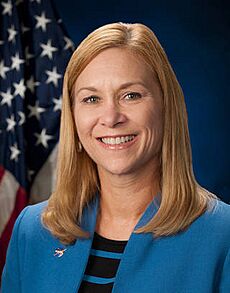
NASA's main office is at NASA Headquarters in Washington, D.C. It provides overall guidance. Most NASA employees must be U.S. citizens. The President of the United States chooses NASA's administrator, and the U.S. Senate must approve them. The administrator serves as a senior space science advisor. The current acting administrator is Janet Petro, appointed by President Donald Trump on January 20, 2025. The Trump administration has also nominated Jared Isaacman as the official administrator, but the Senate has not yet confirmed him.
Strategic Plan
NASA has four main goals for fiscal year 2022:
- Learn more about space through new scientific discoveries.
- Send humans to the Moon and Mars for long-term exploration.
- Help the economy grow and create new solutions for national challenges.
- Improve its abilities and operations for current and future missions.
Budget
NASA's budget requests are created by NASA and approved by the administration. Then they are sent to the U.S. Congress. Authorized budgets are those approved by both houses of Congress and signed into law by the U.S. president.
NASA's budget requests and approved budgets are listed below:
| Year | Budget Request in bil. US$ |
Authorized Budget in bil. US$ |
US Government Employees |
|---|---|---|---|
| 2018 | $19.092 | $20.736 | 17,551 |
| 2019 | $19.892 | $21.500 | 17,551 |
| 2020 | $22.613 | $22.629 | 18,048 |
| 2021 | $25.246 | $23.271 | 18,339 |
| 2022 | $24.802 | $24.041 | 18,400 est |
Organization
Budget allocations to Mission Directorates Science (32%) Exploration Systems (28%) Space Operations (17%) Mission Support (14%) Space Technology (5%) Aeronautics Research (4%)
NASA's funding and priorities are managed through its six Mission Directorates.
| Mission Directorate | Associate Administrator |
% of Budget |
|---|---|---|
| Aeronautics Research (ARMD) | Catherine Koerner |
|
| Exploration Systems (ESDMD) | Jim Free |
|
| Space Operations (SOMD) | Ken Bowersox |
|
| Science (SMD) | Nicola Fox |
|
| Space Technology (STMD) | Clayton Turner (acting) |
|
| Mission Support (MSD) | Robert Gibbs |
|
NASA operates 10 major field centers. Each center is led by a director (data below valid as of December 23, 2024).
| Field Center | Primary Location | Director |
|---|---|---|
| Ames Research Center | Moffett Field, California | Eugene Tu |
| Armstrong Flight Research Center | Edwards, California | Bradley Flick |
| Glenn Research Center | Cleveland, Ohio | James Kenyon |
| Goddard Space Flight Center | Greenbelt, Maryland | Makenzie Lystrup |
| Jet Propulsion Laboratory | La Cañada Flintridge, California | Laurie Leshin |
| Johnson Space Center | Houston, Texas | Vanessa Wyche |
| Kennedy Space Center | Merritt Island, Florida | Janet Petro |
| Langley Research Center | Hampton, Virginia | Dawn Schaible (acting) |
| Marshall Space Flight Center | Huntsville, Alabama | Joseph Pelfrey |
| Stennis Space Center | Hancock County, Mississippi | John Bailey |
Sustainability and Environment
Environmental Impact
The gases from rocket engines can affect Earth's environment. Some rocket fuels are toxic before burning. Rockets using hydrocarbon fuels, like kerosene, release carbon dioxide and soot. However, these carbon dioxide emissions are very small compared to other sources. For example, a single Falcon 9 rocket burns about 25,000 U.S. gallons (95,000 liters) of kerosene per launch. Even if one launched every day, it would be a tiny fraction of daily liquid fuel use. Engines using liquid oxygen and liquid hydrogen produce mostly water vapor. NASA has worked to address environmental concerns with its programs. ion engines use harmless noble gases like xenon.
NASA also works on environmental efforts like the NASA Sustainability Base. The Exploration Sciences Building received a high environmental rating in 2010. In 2003, the Environmental Protection Agency recognized NASA for being the first federal agency to use landfill gas to produce energy at its Goddard Space Flight Center.
In 2018, NASA and other companies started the CAUTION project. This project aims to improve temperature-sensing coatings for jet engines. The goal is to make jet engines safer, more efficient, and reduce CO2 emissions.
Climate Change Research
NASA also researches and publishes information on climate change. Its findings agree with most scientists that the climate is getting warmer. Some people have suggested that NASA should focus only on space exploration and transfer its climate study to other agencies like NOAA. However, former NASA scientist J. Marshall Shepherd pointed out that Earth science study was part of NASA's mission from its very beginning in 1958. NASA won a Webby People's Voice Award for Green in 2020.
STEM Initiatives
Educational Launch of Nanosatellites (ELaNa). Since 2011, the ELaNa program has given NASA chances to work with university teams. They test new technologies and ready-made solutions by providing launch opportunities for small satellites called CubeSats. For example, two NASA-sponsored CubeSats launched in June 2022.
Cubes in Space. NASA started an annual competition in 2014 called "Cubes in Space." NASA and an education company work together to teach students aged 11–18. Students design and build science experiments to be launched into space on a NASA rocket or balloon. On June 21, 2017, the world's smallest satellite, KalamSAT, was launched through this program.
Use of the Metric System
U.S. law requires the International System of Units (metric system) to be used in all U.S. Government programs, "except where impractical."
In 1969, Apollo 11 landed on the Moon using a mix of U.S. customary units and metric units. In the 1980s, NASA started to switch to the metric system, but still used both in the 1990s. On September 23, 1999, a mix-up between NASA's use of metric units and Lockheed Martin Space's use of U.S. units led to the loss of the Mars Climate Orbiter.
In August 2007, NASA stated that all future Moon missions would use only the metric system. This was done to improve cooperation with other countries' space agencies that already use metric. As of 2007, NASA mostly uses metric units. However, some projects, including the International Space Station, still use a mix of both.
NASA in Media
NASA TV
For almost 40 years, the NASA TV channel has shown content from live coverage of crewed missions to important moments for robotic spacecraft (like rover landings on Mars). It also covers U.S. and international rocket launches. NASA provides the channel, and it is broadcast by satellite and over the Internet. The system started to record important space events for NASA managers. It grew as public interest increased. The Apollo 8 Christmas Eve broadcast from orbit around the Moon was watched by over a billion people. NASA's video of the Apollo 11 Moon landing won an Emmy award for its 40th anniversary.
NASAcast
NASAcast is the official audio and video podcast from the NASA website. Started in late 2005, it has the latest audio and video from NASA, including This Week at NASA and educational materials. Other NASA podcasts, like Science@NASA, are also featured.
NASA EDGE
NASA EDGE is a video podcast that explores different missions, technologies, and projects by NASA. The program started on March 18, 2007. As of August 2020, 200 videos have been made. It is a public outreach video series sponsored by NASA. The NASA EDGE team gives an inside look at current projects. They do this through interviews, on-site broadcasts, and computer animations with top scientists and engineers.
The show explores how NASA has helped society and the progress of current projects in materials and space exploration. NASA EDGE videos can be downloaded from the NASA website and iTunes.
In its first year, the show was downloaded over 450,000 times. As of February 2010, it averaged over 420,000 downloads per month.
NASA and NASA EDGE have also created interactive programs. The Lunar Electric Rover App lets users drive a simulated Lunar Electric Rover. The NASA EDGE Widget provides a way to access NASA EDGE videos, image galleries, and news.
Astronomy Picture of the Day
NASA+
In July 2023, NASA announced a new streaming service called NASA+. It launched on November 8, 2023. It has live coverage of launches, documentaries, and original programs. NASA says it will be free of ads and subscription fees. It is part of the NASA app on iOS, Android, Amazon Fire TV, Roku, and Apple TV, as well as on the web.
Images for kids
-
Sun image by Solar Dynamics Observatory, 2010
-
Planet Mercury image by MESSENGER, 2008
-
Planet Venus image by Mariner 10, 1974
-
Planet Earth image by Apollo 17 crew, 1972
-
Planet Mars image by Viking 1, 1976
-
Asteroid 433 Eros image by NEAR Shoemaker, 2000
-
Dwarf planet Ceres image by Dawn, 2015
-
Planet Jupiter image by Juno, 2019
-
Moon Io (Jupiter) image by Galileo, 1999
-
Planet Saturn image by Cassini, 2016
-
Moon Mimas (Saturn) image by Cassini, 2010
-
Planet Uranus by Voyager 2, 1986
-
Moon Miranda (Uranus) image by Voyager 2, 1986
-
Planet Neptune image by Voyager 2, 1989
-
Dwarf planet Pluto image by New Horizons, 2015
-
Moon Charon (Pluto) image by New Horizons, 2015
-
Helix Nebula by Spitzer Space Telescope, 2007
-
1901 GK Persei supernova by Chandra X-ray Observatory, 2015
-
Carina Nebula by Hubble Space Telescope, 2010
-
Stephens quintet by James Webb Space Telescope, Jul 2022
-
Surveyor 3, Pete Conrad, and Apollo 12 on the Moon, 1969
-
Space Shuttle Endeavor in orbit, 2008
-
Hubble Space Telescope released in orbit after servicing, 2009.
-
James Webb Space Telescope now in orbit, 2025.
-
Opportunity rover on surface of Mars (rendering), 2003
-
Curiosity rover self-portrait on Mars, 2021
-
Perseverance rover during Mars skycrane landing, February 2021
-
Voyager 2, now 24.9 billion kilometers from the Earth, June 2025
-
Orion spacecraft and European Service Module testing, 2020
-
Titan III/Centaur launching Voyager 2 spacecraft, Jul 1977
-
Space Shuttle (STS-124) during launch, May 2008
-
Space Launch System and Artemis I at launch, Nov 2022
-
Lunar Gateway space station, 2020
See also
 In Spanish: NASA para niños
In Spanish: NASA para niños
- List of crewed spacecraft
- List of NASA aircraft
- List of space disasters
- List of United States rockets
- Category: NASA people
- NASA Advanced Space Transportation Program
- NASA Art Program
- NASA Clean Air Study
- NASA Institute for Advanced Concepts
- NASA Research Park
- TechPort (NASA)



